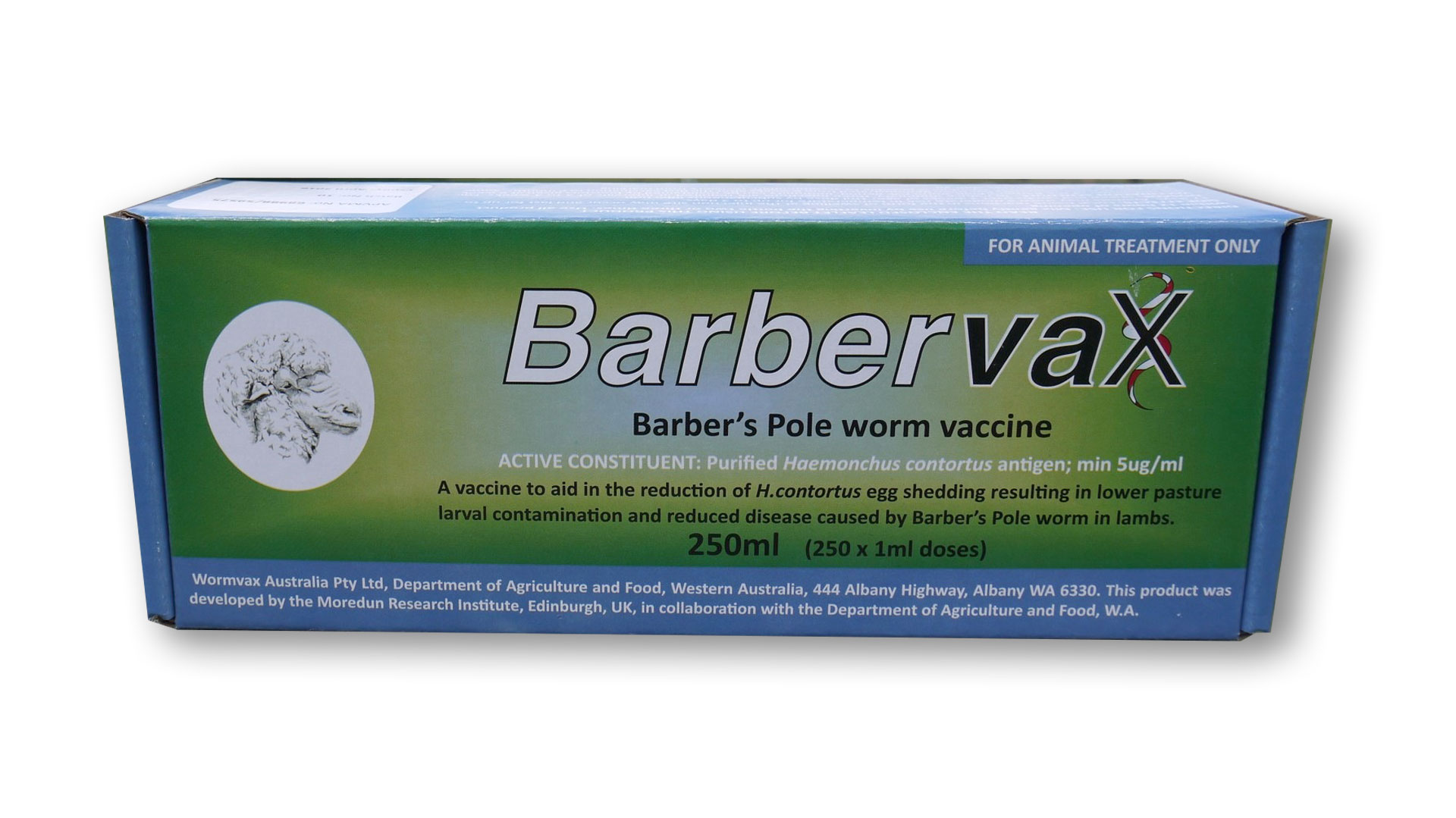Barbervax is the first vaccine for any roundworm parasite which lives in the gut of any host, including man.
Since 2014 it has provided farmers with a revolutionary new tool for controlling Barber’s Pole, the most significant roundworm parasite of sheep.
Unlike with drenches, Barber’s Pole worms that are resistant to the vaccine are not expected to evolve because the vaccine works in a very different way.
Barbervax contains tiny amounts of protein purified from the lining of Barber’s Pole intestines. Like all vaccines, it works by stimulating the natural immune response in the animal after injection. The antibodies produced circulate in the sheep’s blood, so that the parasites ingest them with their blood meal. These antibodies then attach to the lining of the Barber’s Pole intestine, blocking digestion and starving the worm so that it produces far fewer eggs and dies.
Barbervax was developed by the Moredun Research Institute, a UK-based animal health charity first established by farmers in 1920, in partnership with the Department of Primary Industries and Regional Development, Western Australia with support from Meat and Livestock Australia.
Barbervax (and Wirevax) is manufactured in Albany WA by Wormvax Australia Pty Ltd, a wholly owned subsidiary of Wormvax Limited which is wholly owned by the Moredun Research Institute, a registered Scottish Charity. All profits are invested in further research projects aimed at reducing livestock disease.

How to use Barbervax
Visit our ‘How to use’ page for information and advice on using the vaccine on hoggets, ewes and lambs.

How well does Barbervax Work?
Eighty lambs on each of four properties near Armidale NSW were divided into two equal groups, one of which received the recommended course of Barbervax whereas the second group was left unvaccinated as controls. Both groups on each property shared the same paddock.
Samples for worm egg counting were collected every fortnight from October to March. Each lamb’s average count over the summer was calculated and plotted on the graph.
It was very clear that vaccination with Barbervax had depressed the worm egg count on each premises, thus reducing pasture contamination and controlling Barber’s Pole disease.

Buy Barbervax
Visit our ‘Buy’ page to learn how you can order Barbervax, no matter where you are in the world.

Unsolicited testimonials
With our drench resistance problems, if we didn’t have Barbervax we wouldn’t have sheep.
— Brian Lanz, Yarramundi
Barbervax is a terrific product. Very important for our industry. We have been using it on a 10,000 head Merino operation for approximately 6 years. Our ewes are better able to handle the barber’s pole burden and we reduce the number of drenches. I am estimating we would save 2 drenches per year due to Barbervax (maybe it’s 3) and this is critical to maintain high levels of drench efficacy. I am pretty sure that drenches are lasting longer for us (i.e. less drench resistance) than those operations who are not using Barbervax in the high barber’s pole worm burden area of the New England, NSW.
— Charles Coventry, Achill
Barber’s pole worm was beating us and Barbervax has allowed us to stay in sheep.
— Roy Robertson, Wanderriby
We were very pleased with the action of Barbervax on our young sheep in this year. We have got through the spring, summer, and at least mid-autumn without the need to drench for nematode worms.
We used Barbervax across all sheep classes, priming the ewes prior to lambing. We have stuck pretty close to the recommended program for all sheep classes (6 weeks apart once they are primed up) and I think it has worked pretty well. The young sheep we started off last year recommenced the program in September and have simply been on 6 week intervals since then. December/January was wet and we had a bit of worm problem (1000epg average or more in most mobs). We did larval diffs on all mobs and half to two thirds were scour worms. On that, we drenched everything after weaning in January (mainly to address the scour worms), and things are tracking along well again. It maybe hasn’t worked quite as well in the adult sheep as in the young sheep last year, but for us with the drench resistance situation as it is, it is still very worthwhile.
We have been using it in ewes and rams as you know to great results. Tell the scientists if they could just come up with a once year booster for all worms and fly strike….and make it rain.
We are delighted with the first year results and will most certainly be using it again next Spring. I have been spreading the Barbervax good news to any sheep producers I have caught up with in the last six months.
Just awesome results. We are very happy with your vaccine and have been telling anyone who will listen to us about it.
“Barber’s Pole is our single biggest challenge and we have resistance to a lot of drenches. The first vaccination was given at lamb marking the first week of November, the second three weeks later and third three weeks after that and then two more six weeks apart.Costs were on par with our normal program but we expect longer-term savings and will definitely be using it again next season.
It’s a terrific breakthrough for our industry.